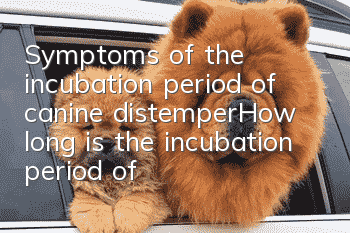Symptoms of the incubation period of canine distemper_How long is the incubation period of canine distemper?

Friends who keep dogs all know about canine distemper. Canine distemper is a highly contagious infectious disease caused by the canine distemper virus and is extremely contagious. The early stage of canine distemper is the best time to treat it. The early symptoms of this virus are very similar to those of a cold. This is also a key point that many parents tend to overlook. If parents do not discover it at this time, it will basically continue into the later stages of canine distemper. Typical neurological symptoms will appear in the later stages of the disease, such as foaming at the mouth, convulsions, etc. At this time, it is generally difficult to cure, but there are some cases of successful cure, but the dog will leave more or less sequelae. In addition to the fact that the symptoms of canine distemper are similar to those of a cold, another main reason why canine distemper is difficult to detect is that canine distemper has an incubation period. So how long is the incubation period of canine distemper?
1. The incubation period of canine distemper
There are generally two opinions on the incubation period of canine distemper in dogs. The first is the usual incubation period, which is from infection to the first fever. This period is about 3-9 days, which is from the time when the virus is infected to the onset of symptoms. The second theory is that it covers the period from the first symptoms to the typical symptoms of the virus. Generally speaking, this period is about 2-14 days. If a dog becomes ill shortly after arriving home, it is possible that the dog has been infected with the virus before purchasing it. So I didn’t notice it because there is an expiration date for canine distemper, that is, the dog is normal during the expiration period, and the virus will attack after a while, and the symptoms are more serious and obvious, and the course of the disease lasts about 7-10 days.
2. Incubation period symptoms of canine distemper
The incubation period symptoms of canine distemper are severe, and its neurological symptoms are one of the characteristic symptoms of the disease. They generally appear in three situations: 1. Appear 7-21 days after the recovery of systemic symptoms; 2. Appear when the fever first begins. ; 3. Appears after severe systemic symptoms. The symptoms are mainly manifested in the local twitching of the lips, eyelids, ears, and one forelimb or hindlimb of the sick dog. In severe cases, they can include salivation, empty chewing, foaming at the mouth, falling to the ground and convulsions, and an epileptic seizure. After the convulsions stopped, some barked, turned in circles, and rushed. The duration ranged from seconds to minutes, and the number of attacks also increased from several times a day to more than ten times. A small number of sick dogs may survive after treatment, and some are accompanied by sequelae such as hindquarter weakness and local twitching of limbs and face. During the onset of systemic symptoms, some sick dogs are accompanied by dry nose, swollen pads, excessive hyperplasia, and keratinization, forming hard pad disease. A few sick dogs may also have bean-shaped papules on their abdominal skin.
3. Characteristics of canine distemper virus
Canine distemper rarely occurs alone. In most cases, there is mixed infection. Secondary bacterial infection is one of the main reasons for increased mortality. If it is complicated by pneumonia, the mortality rate can be as high as more than 90%. Dogs that are still in the poisoning period after recovery, and other animals carrying canine distemper virus, mainly sick dogs and virus-carrying dogs. The virus exists in the liver, spleen, brain, kidney, and lymph node tissue, and is transmitted through tears, nose juice, saliva, and urine. Liquids and exhaled air detoxify outside the body, contaminating the surrounding air, water sources, food, utensils, etc.Become a vector for the disease. Clinically recovered dogs can detoxify to the outside world for a long time and are a source of infection that is often ignored by people. Therefore, canine distemper can be transmitted through nasal and eye secretions and urine.
- How to make your dog like to eat dog food Four ways to make your dog fall in love with dog food
- How to protect your dog’s food? Teach you tips on training your dog
- What should I do if my dog has lupus? Immune system diseases should not be underestimated
- If your dog's hair is cut and the skin is cut, the flesh is exposed. If the dog's hair is accidentally cut and the skin is cut, it must be disinfected immediately.
- Do dogs need deworming in summer? What should you pay attention to when raising dogs in summer?
- What to do if your dog has indigestion? Dog indigestion is no small matter!
- What should you pay attention to when vaccinating your dog? What should you pay attention to when vaccinating your dog?
- Symptoms of Rheumatism in Dogs What conditions can cause rheumatism in dogs?
- What to do if dogs fight at home? The owner is the best mediator
- What are the reasons why dogs are obese? Do you know these four reasons?



